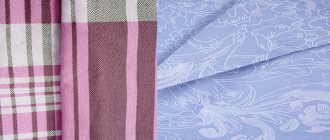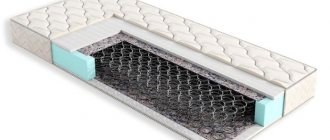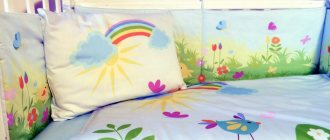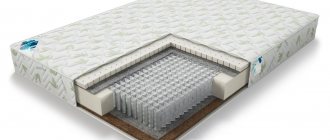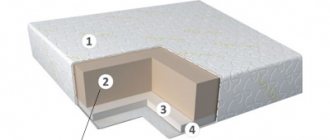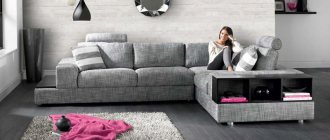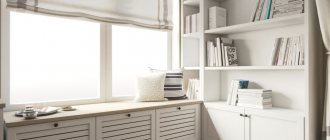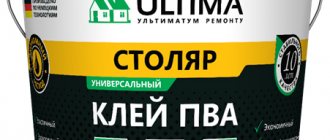What is calico
Calico is a material consisting entirely of cotton . A distinctive feature is the presence of plain weave . Thin and thick threads are intertwined. This technique allows you to create durable fabric. Calico has a matte finish.
Areas of application:
- Making clothes.
- Furniture upholstery.
Types of material are presented in the table.
| Variety | Description |
| Harsh | The densest type. What is it used for: · Tailoring of workwear. · Furniture production (upholstery). |
| Plain painted | The fabric is dyed one color. Used for lining suits and outerwear. |
| Bleached | Used for sewing bed linen |
| Printed | The material on which the design is applied. Used for sewing dresses and sundresses. |
The production process includes the following stages:
- Production of bleached calico.
- Application of various designs to the canvas. They lie flat and beautiful (due to special weaving).
- Sewing bed linen.
Bleached material is widely used in medical institutions.
Types of density of calico fabric:
- 100 g/sq. m - the cheapest option. Not suitable for everyday use. Best used when guests arrive.
- 125 g/sq. m - the option can be called optimal. Advantage: it does not shrink too much after the first wash.
- 140 g/sq. m is the best calico; it began to be produced back in Soviet times. It has high quality and long service life. Recommended for daily use. Withstands a maximum number of washes (300).
The fabric standard in the Russian Federation is 100% cotton . In some countries (Pakistan, India) a polyester thread is added to the fiber. The maximum additive content is 15% of the composition. This should be taken into account when choosing bedding.
White calico is considered the most comfortable and aesthetically pleasing. To obtain a uniform color, the material is treated with special bleaches. These products do not pose a danger to humans and the environment.
The birth of cotton fabrics
Since ancient times, people have been using cotton fabrics to make clothes, bedding and other household items. The cotton from which calico is made was still known in the fifth century BC, as evidenced by the notes of Herodotus. He wrote that in India there is a plant from the fruits of which “wool” is obtained, superior to sheep’s in softness and color. Cotton appeared in Ancient Egypt much later, and around the 15th century it became known in Western Europe. It was at this time that the triumph of cotton fabrics began, which were used for sewing clothes, bed linen and room decoration.
The first samples of cotton fabric were made mainly in Italy and were the prototypes of modern twill and calico, muslin and cambric. But the best demand was for fabrics produced in the countries of the Arab East, since at that time developed textile production already existed there. Even by the names of the fabrics you can determine where they were first produced. For example, “muslin” comes from the name of the city of Mossul, “dama” from a city called Damascus. The word calico is of Arabic origin (bazz) and means dense cotton fabric made by plain weave.
Advantages of bedding made from calico
Advantages:
- Compliance with environmental requirements . The material consists entirely of natural cotton. Therefore, allergic reactions and redness of the skin are excluded.
- No harmful substances are released during operation.
- Low cost (compared to other natural fabrics). People with low incomes can afford to buy bedding made from calico. A simple weaving method facilitates production and reduces the cost of the product.
- Wear resistance is at a high level. The minimum number of washes is 300 (the quality does not deteriorate).
- Preservation of color for a long period of time.
- The fabric does not stretch or deform.
- Long service life.
- Easy to wash.
- Easy ironing , no need for steaming.
- Permeable to air (human skin breathes during sleep).
- The material is pleasant to the touch.
- Does not accumulate static electricity (no need to use special antistatic agents).
- Calico is hygroscopic (capable of absorbing moisture).
- Large selection of drawings . Thanks to the special weaving, the pictures turn out bright and beautiful (provided that high-quality dyes are used).
- Does not require steaming before ironing.
- In the hot season the fabric cools, in the cold it warms.
History of calico in Russia
Calico appeared in Russia in the 16th century, thanks to the activities of merchants who brought quite a lot of goods from Asia. In those days, calico was used in Russia when sewing outerwear - caftans, opashes as lining fabric. With the development of the textile industry in the 17th-20th centuries, bleached calico found use in the clothing industry, where it was used to make underwear, mainly for soldiers, since calico was much cheaper than similar materials. In addition to this type of fabric, such fabrics as glazed and printed were produced. The first was used as a lining or duplicating material when sewing outerwear and suits. Printed calico has found application in light industry for sewing women's dresses and children's light clothing.
The pioneers of the textile industry in Russia are former serfs from the Kineshma district - Konovalov Pyotr Kuzmich and Dmitry Andreevich Rozorenov, each of whom became the founder of a dynasty of weavers.
P.K Konovalov, after receiving his “freedom” from the hands of the landowner A. Khrushchev in 1812, opened a small weaving factory located in the village of Bonyachki near Kineshma. Currently it is the city of Vichuga, Ivanovo region.
Dmitry Andreevich Rozorenov, who was a serf first of Prince Kurakin, after General Pavlenkov, received freedom only in the 40s of the nineteenth century, and only thanks to the fact that his sons Gerasim and Alexey twenty years ago were able to found two weaving and dyeing enterprises in the village of Tezino, Kineshma district . The money he earned was enough to buy his family out of serfdom. Their father's freedom cost the Razorenov brothers 100,000 rubles, but at the same time Dmitry Andreevich Razorenov himself was allocated a plot of land of 30 acres. Afterwards, the sons expanded their production, bought a steam engine, and in the second half of the nineteenth century their factories became mechanized.
A little later than the Kinesh ones, weaving factories for the production of cotton fabrics, including calico, appeared in the south of Russia - around present-day Yerevan, which at that time was called Erivan, and near the city of Ganja (former name Elisavetpol, Kirovobad). In Tbilisi (the old name of Tiflis) a weaving factory was opened in 1870, which produced only calico in large quantities. Every year, the Georgian enterprise produced up to four million arshins of calico fabric, which was divided into two types - shilya and khanagai, and shilya was a simple linen, khanagai of higher quality.
Disadvantages of the material
Flaws:
- Lack of shine . For many people this is a significant drawback.
- The appearance of pellets (it is important to note that they appear after a long period of time after the start of use).
- The fabric has a rough surface.
- Do not wash together with synthetic fabrics, otherwise calico will lose its softness.
- Shrinks after the first wash.
- Long drying due to the fact that cotton fiber absorbs moisture.
Dimensions
Having decided on the fabric, you need to choose the right size of bed linen. To do this, you need to know the dimensions of your sleeping place and pillows.
Now the size range can be divided into Russian and Euro. Russian sets have square pillowcases, while Euro ones have rectangular ones.
There is no single standard for bed linen; sizes may differ from different manufacturers.
Below are the most common sizes.
The children's kit usually includes:
- one pillowcase measuring 40x60 cm;
- sheet 100x150 cm;
- duvet cover 112x147 cm.
One and a half domestic:
- pillowcase 70x70 cm;
- sheet 150x215 cm;
- duvet cover 145x210 cm.
One and a half euro:
- pillowcase 50x70 cm;
- sheet 180x220 cm;
- duvet cover 160x220 cm.
Double set:
- pillowcase 70x70 cm;
- sheet 200x220 cm;
- duvet cover 180x210 cm.
Euro king size:
- pillowcase 50x70 cm;
- sheet 220x240 cm;
- duvet cover 200x220 cm.
Family set "duet":
- pillowcase 70x70 cm;
- sheet 220x240 cm;
- two duvet covers 150x210 cm.
Sheets with elastic bands are designated Fitted sheet.
Recommendations for extending service life
Calico bed linen does not require complex care. A number of recommendations are presented in the table.
| Wash | It is best to use the “Cotton” or “Delicate” modes. The maximum temperature is +40 degrees Celsius. It is important not to use aggressive detergents; chlorine is also not recommended (fabrics will lose color and strength). You should use conditioner (the laundry will become soft and fresh). |
| Spin | The maximum number of revolutions per minute is 800. |
| Drying | It is best to dry clothes in the fresh air. The position can be any (horizontal or vertical). Before drying, laundry should be shaken well. This will help the fabric straighten out. |
| Ironing | It is preferable to use moderate temperature conditions. The product must first be turned inside out. It is best to iron slightly damp bedding. If there is embroidery, the item should be ironed only on the reverse side (otherwise the handmade work will be ruined). |
| Storage | The best place is a ventilated closet. |
After purchasing a product, it is important to study the label . There are special icons that provide assistance in the process of caring for the item. Before first use, the bedding set must be washed.
To save your budget, you need to choose only trusted suppliers. They tend to be customer oriented and offer high quality products. If you buy bed linen in bulk, the prices are much lower.
In addition to the main types, there are:
- calico luxury;
- standard;
- comfort;
- light;
- ranfors.
Calico-luxury
Lux received the title “Best Fabric for Bed Linen” due to the fact that its production uses threads one and a half times thinner than traditional ones and more durable. Engineers from the Nordtex corporation were able to achieve this quality using modern, cutting-edge technologies and innovations. This fabric is soft and smooth to the touch; you can’t hear the pellets under your hands that are inherent in other types of high-density calico.
Standard, Comfort, Light
All other types of calico, except the last one, are produced with different densities, which is why the quality of the fabric is different. “Gost” has a density of 142 g/kW m, “Standard” – 125 g/kW m, Comfort – 120 g/kW m, Light – 110 g/kW m.
Calico calico of the Standard, Light and Comfort types, characterized by high strength, low shrinkage, and breathability, is mainly used to sew bed linen for adults and children, as well as women's dresses, sundresses and robes, and children's clothes.
A large selection of colors makes it possible to select the fabric for everyone according to their taste and preferences.
Ranfors
It is worth mentioning separately about Ranfors fabric. It may not exactly be calico, but it is made from 100% cotton and is often called even-density calico. Its difference from traditional calico is that the high density of the fabric is achieved by increasing the threads in one square centimeter. If for ordinary calico the norm is 42 threads, then Ranfors contains 57 threads. Usually, calico with such a high density of weaving threads is characterized by excessive rigidity, but in the case of Ronfors fabric this does not happen, thanks to new technologies for processing cotton fiber. It feels more like poplin than calico. High-quality material retains its original color and product integrity for many years.
Bed linen care
There are several rules for washing and caring for any bed linen, following which you will extend their service life and maintain their original appearance.
Immediately after purchase, turn inside out and wash. All washing features are indicated on the label and tags.
Colored cotton and linen are best washed at temperatures up to 60 degrees. Undyed linen can be washed at 90 degrees and even boiled.
Natural fabrics shrink slightly when washed, and the higher the temperature, the greater the shrinkage.
Do not leave laundry in the machine after washing; hang it out to dry immediately.
It is better and easier to iron clothes when they are slightly dry.
Blanket
By the way, about blankets. A truly high-quality blanket should also be made only from natural materials - down or wool, sheep, llama or camel.
For example, why is a blanket made of camel wool so loved and why is it so beautiful? Camel wool has many interesting properties, some of which are explained by the special hollow structure of the hair.
And this cavity really turned out to be a very useful invention of evolution. As you know, the habitat of camels is very arid and characterized by large temperature changes.
In the desert, daytime temperatures are 55-60 degrees Celsius, on particularly hot days up to 70 degrees. Night temperatures range from 10 to -10 degrees Celsius.
It is the internal cavity that allows camel wool to be a wonderful thermal insulator, preventing overheating or hypothermia.
This cavity also makes camel wool lighter than sheep or goat wool.
When using wool to make a blanket, we get a unique product - a very light blanket under which it is not hot in summer and not cold in winter.
Density
A very important parameter; quality and wear resistance depend on it. The density value characterizes how many threads are contained in 1 sq. cm surface. The higher the indicator, the longer the bed will last.
There is a classification of fabrics depending on density (values are given for 1 sq. cm).
- Low – 25–35: cambric.
- Below average – 36–50: calico.
- Average – 51–64: linen.
- Above average – 65–94: Turkish silk.
- High – 95–200; satin and poplin.
- Very high – more than 200: Japanese silk, percale.
Typically, this indicator is rarely indicated on the label. If the manufacturer indicated the density, then honor and praise to him.
conclusions
Having studied the characteristics of various materials, we can give some recommendations regarding the purchase of bed linen.
- For every day, budget calico or poplin with neutral colors is suitable. Those who can afford more expensive products should take a closer look at satin and percale.
- For lovers of rough textures, linen is the ideal choice. Plus, it's in fashion now.
- Flannel or terry will provide additional comfort and warmth in winter, and silk will cool you down in the heat.
- Calico, chintz and percale are ideal for children.
- Products made from elite materials will be good as a gift.
Do not hesitate to ask the seller to open the set and carefully inspect the contents: check the seams and the inside, rub the front side with your palm and smell the textiles. Remember that you choose your own comfort and healthy sleep, so scrupulousness will be your best friend. Happy shopping and sweet dreams!
Share how you choose bed linen? Which fabric is most comfortable for you?
How to choose the right bed linen? Which one is right for you? And which one should you choose?
Often, bed linen manufacturers indicate in the product information, “GOST 31307-2005 Bed linen. General technical conditions." This GOST regulates the dimensions allowed in the manufacture of bed linen (Length and width of pillowcases, duvet covers, sheets. Shapes and dimensions of the cutout of the duvet cover, etc.) This GOST also establishes the minimum acceptable values for such technical requirements for fabric as breathability, hygroscopicity, density and etc. Of course, this is a very good and necessary GOST, but the material used for the manufacture of bed linen according to this standard can be either natural or artificial, denser (and therefore better quality) and less dense, the weave of threads can be calico, satin, etc. poplin and so on. As you already understand, bed linen, according to this GOST, can be made from any fabric that meets the minimum technical requirements. And in order to make it easier for you to understand what fabric is used to make bed linen and what suits you best, we suggest that you read this article.
We will try to answer some questions that we all face when buying bed linen, dive a little into history and hope to make your choice at least a little easier. One of the most important postulates that is worth remembering: comfortable sleep and the safety of our health depend on the correct or incorrect choice of bed linen.
And also, don’t be afraid to experiment and buy bed linen of different fabric composition and thread weaving, in order to find your own - something that will be comfortable for you. At the same time, try to comply with one condition - the underwear should be predominantly made of natural materials, without synthetics, viscose and artificial silk. Linen made from natural fabrics has an invariable advantage over synthetics: it can “breathe” and is safe for health. Bed linen fabric is distinguished by: - the composition of the raw materials from which the fabric is made. It could be: linen, cotton, bamboo, silk, etc. - by type and density of thread weave. It can be: chintz, calico, satin, percale, jacquard, mako-satin. Thus, terms such as “calico”, “poplin”, “satin” do not speak about the composition of the fabric, but about the method of weaving it.
Composition of fabric (raw materials)
Cotton
A fiber of plant origin obtained from cotton bolls of plants of the genus Gossypium.
Cotton is one of the oldest plants, the ancient Greek historian Herodotus, who lived in the 5th century before our century, mentioned this amazing plant in his notes, he wrote that “cotton fabrics are obtained from trees on which, instead of fruits, wool grows, superior in quality to wool sheep."
India is the birthplace of cotton cultivation. Cotton's journey around the world was slow. At first, cotton penetrated into China and clothes were not made from it, since they preferred locally produced silk, and this culture was only decorative. Only many centuries later was cotton appreciated in China. And only then it began to be imported to Europe.
Today, the largest cotton producers are China, India and the USA. For industrial purposes, two types of cotton are mainly used: medium-fiber and fine-fiber. Their significant difference lies in the periods of ripening, fiber length and harvest amount. It is believed that the thinner and longer the cotton fiber, the better the quality of the yarn. Due to its unique qualities, cotton fabric is rightfully considered one of the most common options for bedding sets.
Cotton fabrics are heat-resistant, comfortable to wear, pleasant to the body, very durable; as a rule, by strength they mean repeated stretching, abrasion and bending of the fabric, and have good hygienic properties. The main feature of this fabric is its ability to absorb moisture up to 20% of its own weight, without becoming wet to the touch. The minor disadvantages of this fabric include the fact that it dries rather slowly.
For sewing linen, cotton fabrics such as chintz, satin, calico, flannel, cambric, etc. are used.
Linen
A plant fiber that is obtained from the stems of the flax plant, and the fiber is spun into yarn for linen.
Flax is incredibly beautiful when it blooms - then the whole field turns bright blue and plays with different shades in the sun. This beautiful fairy tale can only be seen in the morning, as the rest of the time the flowers either fold or fall to the ground like snowflakes. Flax, like cotton, is the oldest agricultural plant. It began to be cultivated in the Neolithic era (8th–3rd centuries BC). This is confirmed by the discovery of samples of fabrics, threads of rope, and flax nets, which were found during excavations of an ancient village near one of the Swiss lakes. In archaeological finds of the Bronze Age in Spain, traces of linen products were discovered. But most of the finds of flax cultivation date back to the Iron Age - from them we can say that flax was already grown throughout Europe. Some scientists suggest the birthplace of flax is western Persia, from where it came to other countries: China, Asia, India, Babylon and Egypt. From Egyptian wall paintings (IV century BC) one can see the technology for producing and processing linen: it was pulled, dried, crumpled, ruffled, carded and manually spun using a spindle. In Russia, flax has been cultivated since ancient times. The cultivation of flax was carried out by the Slavic tribes who inhabited the eastern part of the European Plain to Kievan Rus. Commercial flax growing in Rus' arose in the 13th century, and with the formation of the Russian state, the center of flax production shifted to Pskov, Novgorod, and then to the Suzdal lands.
The Tale of Bygone Years:
“The Russians spread flax straws, and after the August fog and sun separated the fiber from the stems, they collected it, dried it, crushed it, ruffled it, carded it, separating the silky fiber from the tough chaff. On the day of Praskovya Flax, the patroness of flax growers (October 28), the first linen of flax from the new harvest was spread out for bleaching. The fruits of the labors of Russian peasants—raw flax, shirts, sundresses—were bought up by merchants from Flanders, Germany, and Byzantium.”
Linen is used not only for making fabric. Here's what else is produced from flax: oil, cambric, Brussels and Vologda lace, tablecloths, clothes, sails.
Linen has unique sanitary and hygienic qualities, durability, strength and resistance to rotting. Linen fabric is hygroscopic, i.e. not only absorbs moisture, but also “removes heat”; linen fabric is always fresh and cool. Flax does not cause allergies and inhibits the development of bacteria. Silica contained in flax protects it from rotting. Linen has a smooth surface with a characteristic muted shine.
When caring for linen linen, you must follow several rules: wash at a certain temperature indicated on the care label for a particular product and iron while damp, avoiding over-drying the product. Some manufacturers allow linen fabric to be mixed with cotton, which makes caring for the product easier.
Silk A natural fiber obtained from the cocoon of the silkworm.
The first mention of the silkworm was found in ancient Chinese manuscripts in 2600 BC. And in 2000 BC. In the southwest of Shanxi province, silkworm cocoons were found. The Chinese people very carefully kept the secret of making fabric - silk. Nevertheless, the secret was still taken outside of China. One version is that in the 4th century. AD When the Chinese princess got married, she presented her fiancé with silkworm cocoons as a gift - this was the beginning of silk's journey around the world. For a long time, silk fabric was worth its weight in gold and was available exclusively to the rich. The process of obtaining silk thread begins with the silkworm laying eggs on the leaves of the mulberry tree. Then, after 8-10 days, larvae of about 3 mm appear from the eggs (greens). They are dark brown in color and covered with tufts of long hair. The hatched caterpillars are transferred to a special food shelf in a well-ventilated area. The caterpillars begin to eat fresh mulberry leaves with appetite. Then there is a process from the caterpillar to the creation of the cocoon. The cocoons produced by spinner caterpillars are very diverse in shape, size, and color. After about 20 days, a butterfly emerges from the pupa. But not every caterpillar that weaves a cocoon can turn into a butterfly. Most of the cocoons are used to obtain raw silk. The pupae are killed with steam, and the cocoons are soaked and unwound on special machines. Silk is a truly unique fabric; in its chemical composition it resembles human hair: it consists of 97% proteins, 3% fats and waxes, in addition, it contains 18 amino acids that have a positive effect on human metabolism. Silk is hygroscopic - it absorbs moisture up to 35-50% of its own weight, it does not electrolyze, is breathable, and has a beneficial effect on the skin due to the content of glycine, alanine, sericine, and tyrosine (amino acids) in its composition. Silk is a hypoallergenic material, it is able to prevent the proliferation of pathogenic microbes and does not accumulate dust. The disadvantages of silk include the fact that it quickly deteriorates under the influence of sunlight, which is also confirmed by moth attacks. It is not difficult to distinguish natural silk from artificial silk; to do this, you need to pull out a few threads from the fabric and set them on fire. If the silk is natural, the smell should resemble burnt horn or wool. Viscose, unlike silk, will smolder and smell like burnt paper, and polyester will melt. There are many varieties of silk: Lebanese birotin, Chinese pelums, fine French glace, Indian matabis, damask, muslin, gauze, etc. Only natural fabrics have the above properties.
Tailoring quality
Good underwear is made from a single cloth. If a duvet cover or sheet is assembled from several pieces with a seam in the middle, then this indicates low-quality manufacturing, and is simply inconvenient for daily use.
In addition, it is important to pay attention to the seams, which will tell you about the textile you like.
The seams should be smooth and the edges should be finished.
All items are stitched with a special linen seam, in which the cuts are carefully hidden. This prevents fraying of the edges and unraveling of the stitches.

